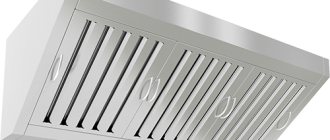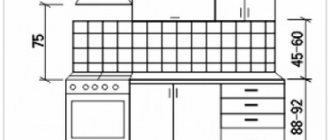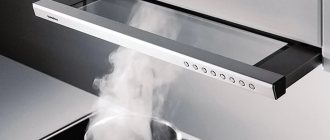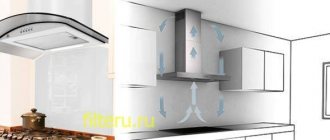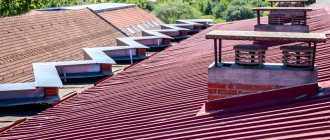Cooking meat, fish and vegetables on the grill is a traditional, pleasant, festive affair, but it has its drawbacks. The process is sometimes interrupted by bad weather, and the smoke wafting through the yard creates some discomfort for those around. To make grilling barbecue a pleasure, use a barbecue umbrella. The element is installed above the firebox and serves as a smoke exhaust.
Useful functions and operating principle
Making the exhaust part with your own hands is a feasible task. The smoke collector for the barbecue performs two main functions:
- Removal of volatile compounds. In essence, an umbrella is a chimney that raises the gases generated during combustion. Like the barbecue oven system, the action is based on draft force. With sufficient combustion intensity, the smoke heats up to such a temperature that it becomes lighter than the surrounding air and tends upward. If an umbrella is installed, combustion products do not have time to dissipate, but are collected in a pipe and released only at the end of the chimney. Thus, all unpleasant compounds disappear without causing harm to humans.
- Protection of the frying surface from precipitation. This is ensured by the presence of a smoke collector, which, due to expansion, covers the entire grill. Typically, this function is performed by a gazebo or canopy, under which a frying device is installed, but an umbrella allows you to use the grill both under the roof and in an open area.
Brick chimney
First, you need to find a place on the site to build a furnace. It is important that the tandoor is not located near the dacha or other wooden buildings. The stove for the cauldron should be taken out of the green spaces.
The hood over the barbecue can be made from brick, which is used to build stoves. It is important to mix the clay-sand solution correctly. You need to pay attention to how the finished mixture adheres to a smooth surface. If the solution does not spread when laid on a brick, then it is ready.
When erecting an exhaust hood for a barbecue in a gazebo, you need to make the base correctly. The laying must be done very carefully. To do this, you need to take the corners and embed them into the walls of the grill. The first row of bricks will be laid on them. In this case, the blocks must be laid along the walls, leaning against them. When laying out the remaining rows, the brick is placed lengthwise. You need to immediately buy a sufficient amount of material, because there will be at least 10 rows.
When laying out the top of the cone, you should pay attention to the slope. A slope of 35 mm is considered normal for the sides, and 17 mm for the front side. But you need to take into account that the dimensions can be changed due to the design of the chimney.
When laying out the hood, you need to make sure that the dimensions of its last row correspond to the dimensions of the chimney. The rear wall of the pipe must have a “tooth”; this element is necessary to improve traction. To protect the pipe from precipitation, a galvanized canopy should be made over it. In enclosed spaces, the structure can be equipped with a fan and filters.
Which oven option do you prefer?
Owners of private houses often build a smokehouse on their property. It is built from brick or arranged in a metal barrel. Which smokehouse is better? It all depends on the preferences of the owner, but brick structures will last longer. In addition, they have a more attractive appearance. For example, a brick grill with a chimney will fit into any landscape design.
You can install a tandoor on the site, but you need a horizontal platform. Previously, meat and bread were cooked in such ovens, today they can be used for smoking fish, etc. Previously, food was smoked in private houses, where special devices were placed, but today you can prepare delicious dishes in the countryside in outdoor ovens.
Umbrella design
Exhaust ventilation is a simple device. Precision is important in manufacturing, so it is recommended to use a drawing. The umbrella consists of 3 parts, each of which serves for gradual smoke removal:
- Smoke collector, or chimney. The task of this element is to collect all volatile compounds from the frying plane into one pass of a narrower cross-section. For rectangular and square barbecues, the classic shape of the smoke collector is a truncated pyramid: 4 sides tapering towards the top. For devices with a round firebox, the collection is a cone.

- A pipe, or, actually, a chimney. The function of this element is to raise the collected smoke to a specified height. As a rule, 3 meters above ground level is sufficient: this is higher than a person’s height and does not allow combustion products to fall in the wind. The shape of the pipe depends on the collector: rectangular cross-section for a pyramidal nozzle, round for a cone. The main thing is to hermetically connect the internal volume.
- An umbrella is a small but important element. It is installed above the pipe at a height of 10-20 cm and protects the chimney from precipitation without interfering with the removal of combustion products.
Possible alternatives

Without breaking the law, you can cook barbecue on the balcony using two heat sources - electricity and gas. Moreover, it is highly advisable to purchase devices made by reputable manufacturers. They pay great attention to safety, so the risk of fire is negligible. But even these devices should not be left unattended.
Electric grill
An electric substitute for a classic barbecue can be:
- horizontal;
- vertical.
Horizontal models are more like regular barbecues. Even skewers with meat in them have to be rotated manually. Vertical devices have the form of an elongated cylinder. In addition to heating elements, they also have drives for rotating the skewers.
An electric grill for a balcony is the safest option. And since there are no prohibitions on its use even in enclosed spaces, no one will be able to make claims against you.
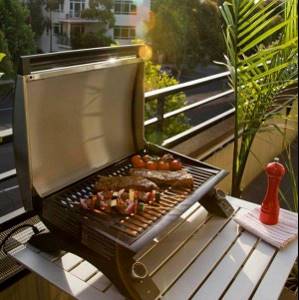
Stationary devices
A stationary barbecue is a massive structure equipped with:
- ventilation holes;
- lid;
- dust collector;
- grill grate, etc.
Such a stove has an impressive and prestigious appearance. But installing a stationary barbecue on the balcony will almost completely deprive it of free space.
Portable devices

Mobile structures for balconies are made using handicraft methods. They are small collapsible boxes. Many models are equipped with hooks for hanging on a balcony parapet.
The design features of portable barbecues are as follows: they can be quickly disassembled and stored away from prying eyes. But according to the law, you still cannot use it on the balcony: even in the smallest drawer there will be an open fire - an obvious source of danger.
Gas grill
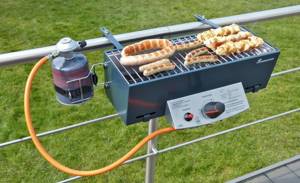
This device consists of:
- A metal grate that acts as a cooking surface.
- Burner.
- Regulator, hoses.
All components of the device are enclosed in a housing. The structure is covered with a lid that helps retain heat inside the grill.
It is impractical to install a stationary gas pipe on the balcony, and no one will give permission for this. There is only one option left - a gas cylinder. It is connected to the gas supply regulators using hoses.

Air fryer
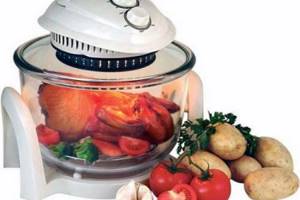
The kitchen unit, which looks like a transparent pan with a lid, is equipped with a heating element and a fan. The lid has a large number of holes. Through them, air masses enter the air fryer. The air rising after heating warms up the food. The fan ensures uniform cooking.
Materials
The choice of material for the exhaust device depends on the design of the barbecue. If the structure is brick, then both metal and brick are suitable for making an umbrella. How do these materials differ:
- Strength and rigidity. Masonry has greater mechanical resistance than metal. Of course, no one is going to drive a tank into the barbecue, but these qualities are useful during operation: the brick structure will not be damaged by accidental impacts, strong gusts of wind, and with high-quality masonry it will not deform over time.
- Service life. Metal rusts, fades in the sun and at high temperatures, so its service life is significantly lower than that of brick.
- Complexity and production time. To make an umbrella from a sheet of steel, you do not need to have masonry skills, mix a binder mortar or carry bricks. It is easier to make a metal hood.
- Cost of expenses. And on this point, steel wins. Buying a sheet of iron will be much cheaper than buying bricks and mortar.
Both steel and brick umbrellas do their job well. There is no difference in the removal of combustion products.
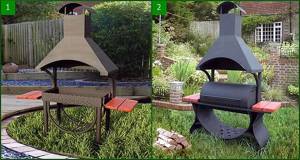
Metal chimneys for: 1) barbecue, 2) barbecue
Barbecue or grill?
The difference between a barbecue and a barbecue is insignificant in technical terms, but quite significant in culinary terms. The product cooked on the grill is almost not exposed to smoke, while in the barbecue the sides of the structure trap the smoke inside, as a result of which the product is slightly smoked.
At the same time, the lingering hot air has a thermal effect on the meat, creating an appetizing crispy crust on it. In addition, the product is baked from the inside without significant loss of moisture. Because of this, meat cooked in this way remains juicy inside, but at the same time tender.
This also has a purely practical significance, since it is not necessary to carefully select the meat for cooking - it will turn out quite soft in any case. In addition, on the barbecue you can fry not only it, but also any other meat and sausage products, which often burst when frying on the grill, as well as vegetables and flatbreads.
Features of brick construction
The basis of the dome is an iron frame welded from a strong corner. Before laying, it is treated with a primer and painted for better protection. Since the temperature directly above the firebox is quite high, the smoke collector is made of refractory bricks. The shape of the structure is stepped, tapering.
Tip: file protruding welds in a metal frame so you don’t have to trim the bricks in the masonry.
The chimney is made of both fireclay and stove bricks. If the barbecue is located in an open area, drainage slopes are made of heat-resistant roofing material on the walls of the smoke collector. Then, during precipitation, moisture will not destroy the building structure. The umbrella over the chimney is metal.
Hood calculation
Thermal power of the fryer.
It is generally accepted that 1 kg of shish kebab requires 0.75-1 kg of coal. For 1 person you need 400-700 grams of meat. The specific heat of combustion of charcoal is 7.5 kW.
And we get for 6 guests we need a grill with thermal power: minimum 0.4*6*0.75*7.5 = 13.5 kW maximum 0.7*6*1*7.5 = 31 kW.
Usually, a large amount of meat is fried on the grill in several batches. For further calculations, we will use a “round number” of power of 15 kW.
Fryer area.
Where: A – width of the brazier, m; B – length of the brazier, m.
D = 2*0.4*0.6/(0.4+0.6) = 0.48 m
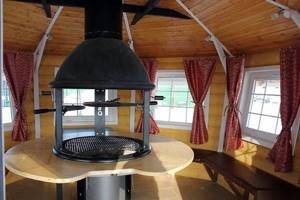
Share of convective heat releases.
Where: QT – thermal power of the barbecue or hearth, kW; KYa is the fraction of sensible heat released from the fryer, the value is taken to be 250 W/kW; KK – fractional part of convective heat releases in relation to sensible heat releases of the fryer, the value is taken to be 0.5.
Qk = 15*250*0.5 = 1875 W
Convective air flow.
Where: k – coefficient equal to 5·10 -3; Qk is the calculated fraction of convective heat release from the fryer, W. z – distance from the grill to the exhaust hood, m, cannot be less than 0.75 m; D – fryer area; r – correction factor for placement conditions: between 3 walls - 0.75, against a wall - 0.8, free or island - 1.1;
Let's calculate for a hood with access to the barbecue from all sides and a minimum height from the barbecue to the hood hood.
Lki = 5·10 -3 *1875 1/3 *(0.75+1.7*0.48) 5/3 *1.1 = 0.224 m 3
Volumetric gas flow rate for combustion products.
Lri = 1.51·10 -7 *15 = 2.26·10 -6 m3
Gas consumption in the hood.
Where: Lki is the value of air flow from the convective flow rising above the slab, m 3 /s; Lri – data on the volumetric flow rate of natural gas combustion products in the stove burners, m 3 /s.
Lo = 224·10 -3 + 2.26·10 -6 = 0.224 m 3 /s
Consumption per hour.
(D)/L = 0.224*3600*0.48 = 421.63 m 3 /h



